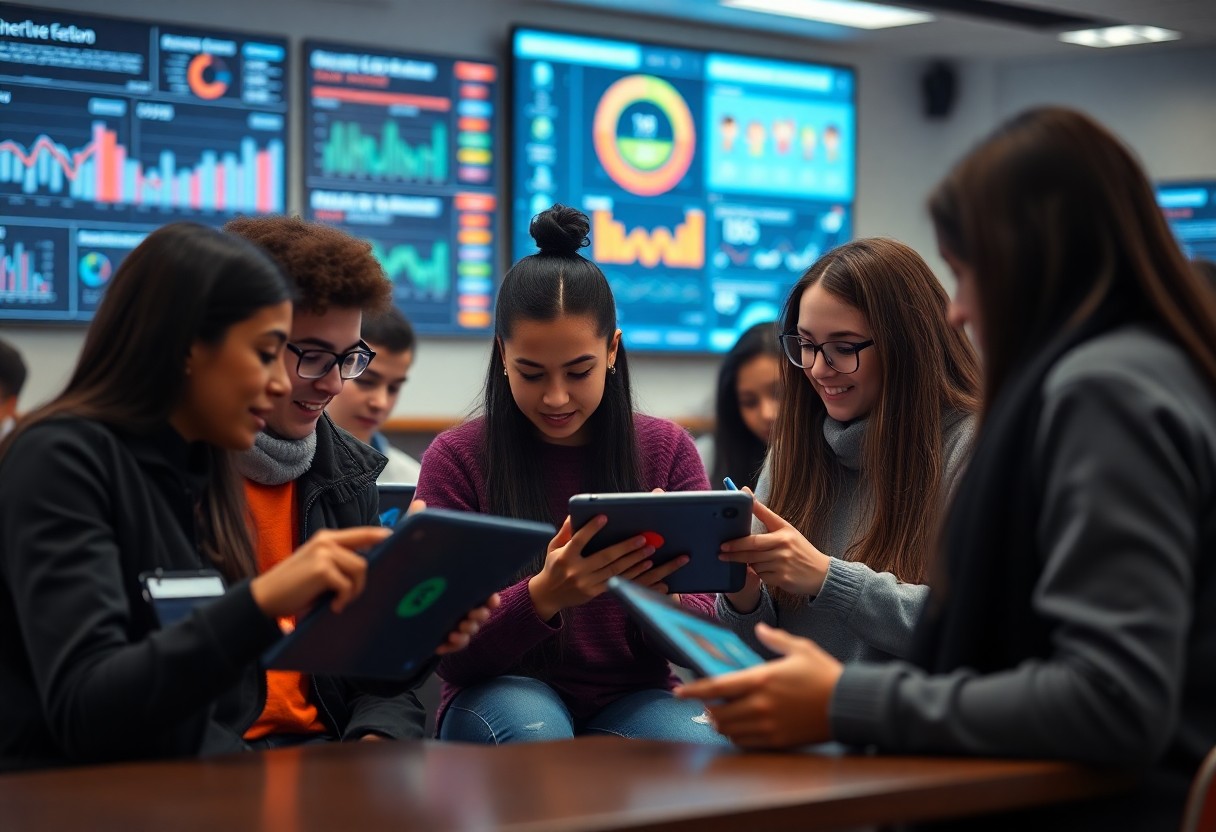Most educators and students are experiencing a profound transformation in the way knowledge is imparted and absorbed thanks to artificial intelligence. As we initiate on a journey through the top 10 ways AI is reshaping classroom learning, we will explore the remarkable potential and exciting possibilities that lie ahead in this innovative digital age.
Personalized Learning Paths
Adaptive Assessments
You’ll find that with the help of artificial intelligence, assessments can adapt to each student’s individual learning pace and style. This means that students are no longer constrained by a one-size-fits-all approach to testing. AI algorithms can analyze a student’s responses to questions and tailor subsequent questions based on their performance. This not only provides a more accurate representation of a student’s knowledge but also helps educators identify areas where individual students may be struggling so that targeted help can be provided.
Customized Curricula
Paths can be designed to create customized curricula specific to each student’s strengths, weaknesses, and interests. AI algorithms can analyze vast amounts of data to determine the most effective learning materials and activities for each student. With personalized learning paths, students can progress at their own pace and focus on areas that need improvement, leading to a more efficient and tailored educational experience.
With customized curricula, students are more engaged and motivated as they are studying topics that are relevant and interesting to them. Educators can also track the progress of each student more effectively and provide targeted support when needed. This level of individualized attention can lead to better learning outcomes and a more fulfilling educational experience for students.
Intelligent Tutoring Systems
The use of Artificial Intelligence in education has led to the development of Intelligent Tutoring Systems (ITS) which are revolutionizing classroom learning. These systems are designed to provide personalized tutoring to students, using advanced algorithms to adapt to individual learning styles and provide targeted support.
Real-time Feedback
You can get immediate feedback on your performance and progress with ITS. These systems can analyze your answers to questions and provide real-time feedback to help you understand where you went wrong and how to improve. This instant feedback can be invaluable in helping you learn more efficiently and effectively.
Human-like Interactions
Feedback in ITS is designed to simulate human interactions, providing a more engaging and dynamic learning experience. These systems can use natural language processing and machine learning algorithms to interact with students in a conversational manner, making the learning process more enjoyable and effective.
Intelligent Tutoring Systems have the potential to revolutionize education by providing personalized learning experiences that are tailored to individual needs. With the ability to provide real-time feedback and human-like interactions, these systems can help students learn more effectively and efficiently than ever before.
Automated Grading Systems
Little did we know that artificial intelligence would revolutionize the way students’ work is assessed in the classroom. Automated grading systems have made the process more efficient, accurate, and timely than ever before. These systems use algorithms to evaluate assignments, quizzes, and exams, providing instant feedback to students and teachers.
Faster Feedback Loops
For students, the immediate feedback from automated grading systems is invaluable. It allows them to learn from their mistakes and make corrections right away, helping to improve their overall understanding of the material. Teachers also benefit from faster feedback loops, as they can identify areas where students are struggling and adjust their teaching methods accordingly.
Reduced Teacher Workload
For educators, one of the most significant advantages of automated grading systems is the reduced workload they bring. Teachers no longer have to spend hours grading papers and can instead focus on planning engaging lessons and providing one-on-one support to students. This shift allows teachers to devote more time and energy to fostering a positive learning environment in the classroom.
Automated grading systems are not meant to replace teachers but rather to supplement their work and streamline the assessment process. By handling the tedious task of grading, teachers can allocate their resources more effectively and focus on what truly matters – nurturing the minds of the next generation.
Enhanced Accessibility Tools
Unlike traditional classrooms, artificial intelligence has revolutionized classroom learning by providing enhanced accessibility tools that cater to a wider range of students’ needs. Through the use of AI, education is becoming more inclusive and accommodating for students with various learning styles and challenges.
Speech-to-Text Software
For students who struggle with written communication or have disabilities that make it difficult to write, speech-to-text software becomes a game-changer. This tool allows students to speak into a device and have their words transcribed into written text, making it easier for them to participate in class activities and complete assignments.
Multilingual Support
While English is often the primary language of instruction in many classrooms, AI is breaking language barriers with multilingual support tools. These tools help students who speak and understand different languages by providing translations and language learning support, creating a more inclusive learning environment.
You can now imagine a classroom where students from diverse linguistic backgrounds can fully engage in learning activities and connect with their peers without feeling isolated or left behind due to language differences.
Virtual Learning Environments
Despite the challenges presented by the traditional classroom setting, artificial intelligence is transforming education through virtual learning environments. These environments provide an interactive and dynamic platform for students to engage with course materials in innovative ways, enhancing their learning experiences.
Immersive Simulations
You’ll find that immersive simulations are a key component of virtual learning environments. These simulations allow students to step into realistic scenarios and explore complex concepts in a hands-on manner. By actively participating in the learning process, students gain a deeper understanding of the subject matter and develop critical thinking skills.
Interactive 3D Models
Now, artificial intelligence enables the creation of interactive 3D models that provide a more engaging and comprehensive learning experience. These models allow students to manipulate objects and explore various angles, enhancing their spatial awareness and problem-solving abilities.
Simulations in virtual learning environments not only make learning fun and engaging but also cater to different learning styles. Whether visual or kinesthetic, students can benefit from these immersive experiences that solidify their understanding of complex topics.
AI-powered Research Assistants
Artificial intelligence is transforming the way students and teachers engage with academic content through AI-powered research assistants. These virtual assistants can provide students with personalized recommendations for research materials, help them navigate through a vast amount of information, and assist in citing sources correctly. For educators, AI research assistants can offer support in creating curriculum materials, suggesting relevant resources, and even providing insights into student performance based on their research habits.
Relevant Resource Suggestions
The AI-powered research assistants can analyze the topics students are researching and recommend relevant resources that they may not have considered. This can help students discover new perspectives, deepen their understanding of the subject matter, and improve the quality of their work. Additionally, these assistants can suggest scholarly articles, books, and online resources that are credible and up-to-date, saving students valuable time in their research process.
Data Analysis Support
Some AI research assistants are equipped with advanced data analysis capabilities, allowing students to gain deeper insights from their research findings. For instance, the AI assistants can help students identify patterns in their data, perform statistical analyses, and generate visualizations to enhance their research papers. This not only helps students develop their analytical skills but also enables them to present their findings in a more compelling and informative manner.
Intelligent Classroom Management
Now, with the integration of artificial intelligence in classroom management, educators can enhance the learning experience for students like never before. AI technologies are revolutionizing the way classrooms are managed, fostering a more efficient and engaging environment for both teachers and learners. Let’s explore two key aspects of intelligent classroom management.
Automated Attendance Tracking
Clearly, one of the most tedious tasks for teachers is taking attendance. With AI-powered automated attendance tracking systems, this time-consuming process becomes a breeze. These systems use facial recognition or biometric data to quickly register students as they enter the classroom, reducing paperwork and providing real-time data to educators.
Real-time Student Monitoring
Any effective teaching involves understanding how students are engaging with the material in real-time. AI facilitates this through real-time student monitoring, allowing educators to track individual progress, identify struggling students, and provide timely interventions. This personalized approach to learning helps improve academic performance and overall classroom dynamics.
A vital component of real-time student monitoring is the ability to detect signs of distress or disengagement. AI algorithms can analyze facial expressions and body language to alert educators when a student may be struggling or in need of assistance. This proactive approach to student support enhances the overall well-being and success of individuals in the classroom.
Natural Language Processing
Once again, Artificial Intelligence is making its mark in the classroom through Natural Language Processing (NLP). NLP enables machines to understand, interpret, and generate human language, providing a range of possibilities for transforming the learning experience.
Language Learning Tools
You might have already come across language learning tools like Duolingo or Babbel that utilize AI-powered NLP. These tools offer personalized learning experiences by analyzing individual learning patterns and providing tailored feedback to enhance language proficiency.
Sentiment Analysis Insights
There’s more to NLP than just language learning tools. By analyzing text data through sentiment analysis, educators can gain valuable insights into students’ emotions, attitudes, and opinions. This can help in identifying at-risk students, improving engagement levels, and creating a more supportive learning environment.
Analysis of sentiments through NLP can also assist in identifying signs of mental health issues such as depression or anxiety in students. By flagging concerning patterns in language use, educators can intervene early and provide necessary support to students in need.

Data-driven Instructional Design
Performance Analytics
Even your most attentive students may struggle with certain concepts, and performance analytics can pinpoint exactly where intervention is needed. By analyzing data from quizzes, tests, and assignments, teachers can identify trends and patterns that reveal areas where students are excelling or facing challenges. This insight allows for personalized instruction that meets each student’s needs, improving overall learning outcomes.
Predictive Modeling
On the horizon of educational technology is predictive modeling, where AI algorithms can anticipate student performance and behavior. These models can forecast how well a student will do on a test, which areas they may struggle with, and even predict when a student is at risk of dropping out. By identifying these patterns early on, teachers can intervene and provide additional support to help students stay on track and succeed.
Instructional designers can use predictive modeling to create adaptive learning systems that adjust the content and pace of instruction based on each student’s needs. This personalized approach can lead to better engagement, retention, and mastery of the material, propelling students towards academic success.
1. Personalized learning experiences for every student.
2. Enhanced student engagement and motivation.
3. Data-driven insights for more effective teaching strategies.
4. Automation of routine administrative tasks for educators.
5. Immediate feedback on student performance and progress.
6. Development of critical thinking and problem-solving skills.
Summing up
Hence, it is evident that artificial intelligence is revolutionizing classroom learning by providing personalized learning experiences, assisting teachers in improving their teaching methods, and creating a more engaging and interactive learning environment for students. With the integration of AI technology in education, students can benefit from advanced tools and resources that enhance their academic performance and skills development. As AI continues to evolve, we can expect further advancements in classroom learning that will ultimately shape the future of education.
FAQ
Q: How is artificial intelligence revolutionizing classroom learning?
A: Artificial intelligence is revolutionizing classroom learning by providing personalized learning experiences, automating administrative tasks, and improving academic outcomes through data analysis.
Q: What are some examples of how AI is used in the classroom?
A: AI is used in the classroom for tasks such as virtual tutoring, grading assignments, identifying learning gaps, and creating customized lesson plans.
Q: How does AI help in personalizing learning experiences for students?
A: AI helps personalize learning experiences by analyzing each student’s learning style, pace, and outcomes to create individualized learning paths and recommendations.
Q: Can AI replace teachers in the classroom?
A: While AI can automate certain tasks and provide support to teachers, it cannot fully replace human teachers who bring empathy, creativity, and critical thinking to the learning process.
Q: What are the potential benefits of AI in classroom learning?
A: The potential benefits of AI in classroom learning include improved student engagement, better academic performance, increased efficiency in teaching, and more personalized learning experiences.
Q: How can AI help in identifying and addressing learning gaps in students?
A: AI can identify learning gaps by tracking student progress, analyzing performance data, and offering targeted interventions and resources to help students improve in specific areas.
Q: Are there any ethical concerns related to the use of AI in classroom learning?
A: Yes, ethical concerns related to AI in classroom learning include data privacy issues, bias in algorithms, over-reliance on technology, and the need for transparent and responsible AI use in education.




